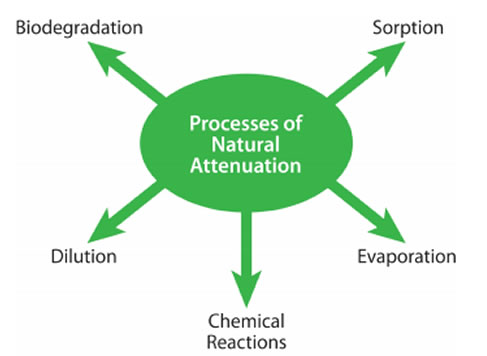Below are excerpts taken from EPA publication: Guide to Monitored Natural Attenuation
Natural attenuation relies on natural processes to decrease or “attenuate” concentrations of contaminants in soil and groundwater. Scientists monitor these conditions to make sure natural attenuation is working. Monitoring typically involves collecting soil and groundwater samples to analyze them for the presence of contaminants and other site characteristics. The entire process is called “monitored natural attenuation” or “MNA.” Natural attenuation occurs at most contaminated sites. However, the right conditions must exist underground to clean sites properly and quickly enough. Regular monitoring must be conducted to ensure that MNA continues to work
How Does It Work?
When the environment is contaminated with harmful
chemicals, nature may work in five ways to clean it up:
• Biodegradation occurs when very small organisms, known as “microbes,” eat contaminants and change them into small amounts of water and gases during digestion. Microbes live in soil and groundwater and some microbes use contaminants for food and energy.
• Sorption causes contaminants to stick to soil particles. Sorption does not destroy the contaminants, but it keeps them from moving deeper underground or from leaving the site with groundwater flow.
• Dilution decreases the concentrations of contaminants as they move through and mix with clean groundwater.
• Evaporation causes some contaminants, like gasoline and industrial solvents, to change from
liquids to gases within the soil. If these gases escape to the air at the ground surface, air will dilute them and sunlight may destroy them.
• Chemical reactions with natural substances underground may convert contaminants into less harmful forms. For example, in low-oxygen environments underground, the highly toxic “chromium 6” can be converted to a much less toxic and mobile form called “chromium 3” when it reacts with naturally occurring iron and water.
MNA works best where the source of contamination has been removed. For instance, any waste buried underground must be dug up and disposed of properly, or removed using other available cleanup methods.
How Long Will It Take?
MNA may take several years to decades to clean up a site. The actual cleanup time will depend on several factors. For example, cleanup will take longer when:
• Contaminant concentrations are higher.
• The contaminated area is large.
• Site conditions (such as temperature, groundwater flow, soil type) provide a less favorable environment for biodegradation, sorption or dilution.
Why Use Monitored Natural Attenuation?
MNA is selected when any contaminant source has been removed and only low concentrations of contaminants remain in soil or groundwater. The anticipated cleanup time for MNA must be reasonable compared to that of other more active cleanup methods. MNA requires less equipment and labor than most methods, which decreases cleanup costs. However, the cost of many years of monitoring can be high.
More information on XDD Environmental’s monitored natural attenuation (MNA) experience and services.

